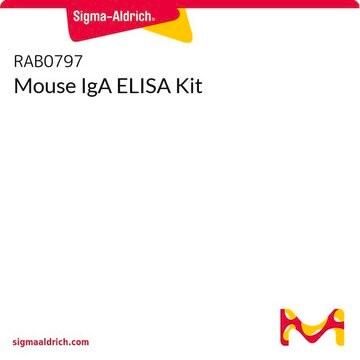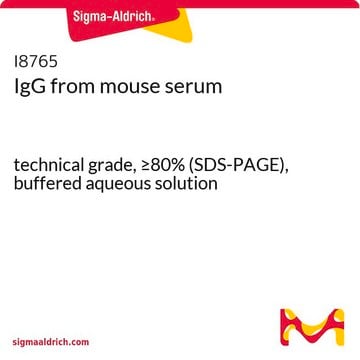11333151001
Roche
Mouse IgG ELISA
Sinónimos:
quantification kit for hybridomas | hybridoma quantification | monoclonal quantification
About This Item
Productos recomendados
usage
sufficient for ≤400 tests
manufacturer/tradename
Roche
technique(s)
ELISA: suitable
shipped in
wet ice
storage temp.
2-8°C
General description
Assay time: Approximately 2.5 - 4.5 hours
Sample material: Hybridoma supernatant, ascites, mouse sera, and purified IgG preparations (the assay is not applicable for the quantification of IgG preparations purified with strongly denaturing buffers, for example, during the elution from affinity chromatrography matrices)
Sensitivity: Approximately 10 ng IgG/ml
Specificity
Application
Biochem/physiol Actions
Features and Benefits
- Reliable: Highly specific antibodies supplied with the kit
- Easy: Follows a standard ELISA protocol
- Fast: Results in 2 - 4 hours
- Sensitive: Detects down to 10 ng/ml
- Highly specific: No crossreactivity with FBS
Packaging
Principle
Preparation Note
- Open standard carefully to avoid loss of lyophilizate material. Add exactly 500 μl double-distilled water. Note: On the label of vial 5, the contents of IgG per vial are provided in mg/fl (flask). Since the contents of the vial are dissolved in 0.5 ml, the IgG concentration (in mg/ml) will be exactly twice the value printed on the label after reconstitution.
- Close the bottle carefully. Allow to the bottle to equilibrate at 15 to 25 °C for 30 minutes. Then dissolve the contents of the bottle completely by gentle swirling. Note: Avoid the formation of foam, and do not shake.
After complete reconstitution, pipette 10 aliquots (50 μl each) into the remaining 10 empty vials, close tightly.
Storage conditions (working solution): Standard Solution
Stable for several months when stored in aliquots at -15 to -25 °C; avoid more than three freeze/thaw cycles.
Other Notes
Solo componentes del kit
- Coating Antibody, anti-mouse-IgG
- Coating Buffer Concentrate
- Detergent
- Blocking Reagent
- Standard
- Conjugate, optimized mixture of anti-mouse-k-POD antibody and anti-mouse-l-POD antibody
- Substrate Buffer
- ABTS Substrate Tablets
- 20 empty vials, for the preparation of the standard dilutions
signalword
Danger
hcodes
Hazard Classifications
Aquatic Chronic 3 - Eye Dam. 1 - Skin Sens. 1
Storage Class
11 - Combustible Solids
wgk_germany
WGK 2
flash_point_f
230.0 °F
flash_point_c
110 °C
Certificados de análisis (COA)
Busque Certificados de análisis (COA) introduciendo el número de lote del producto. Los números de lote se encuentran en la etiqueta del producto después de las palabras «Lot» o «Batch»
¿Ya tiene este producto?
Encuentre la documentación para los productos que ha comprado recientemente en la Biblioteca de documentos.
Los clientes también vieron
Nuestro equipo de científicos tiene experiencia en todas las áreas de investigación: Ciencias de la vida, Ciencia de los materiales, Síntesis química, Cromatografía, Analítica y muchas otras.
Póngase en contacto con el Servicio técnico













